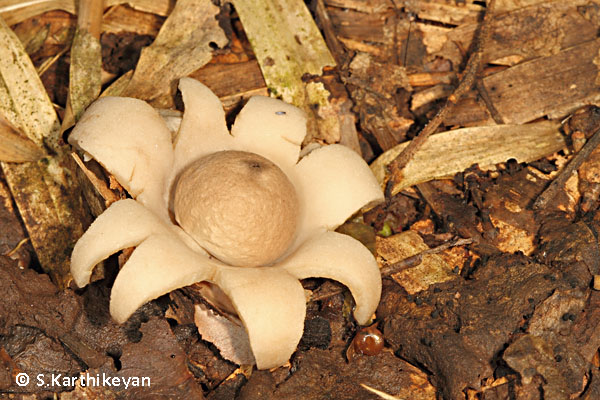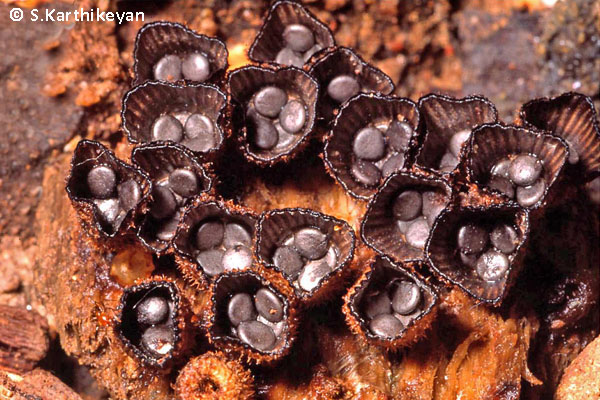Fungi are found all around us! They perform an extremely crucial role in the environment – much more than what meets the eye. We often do not realise this because we don’t see them often. Apart from being nature’s recyclers, fungi also nurture life. To be able to do this, they need to reproduce and disperse their spores.
In fact, in the monsoon and post-monsoon months, which are perhaps the best times to look out for fungi, we can see them growing on the ground, on tree-trunks, on termite mounds, on rotting logs, etc.
During this season, we see them putting forth their fruiting bodies (which contain spores). These fruiting bodies come in an amazing array of shapes, sizes and colours. Fungi also use different mechanisms to disperse their spores. I have earlier written about the Stinkhorn Mushroom where the dispersal mechanism is explained.
Here, I am going to introduce you to two very interesting fungi. Both of them are dependent on rain to disperse their spores!
Earth Star
I visited a friend a couple of days ago in Bangalore on an invitation to see the different fungi growing in his garden. Little did I realise that he would point towards a partly shrivelled and at the same time very different looking fungus. This was on the ground at the base of a thicket lining the path leading to the house.
This instantly reminded me of what I had seen and photographed during a routine visit to the River Tern Lodge, Bhadra during August 2010. While walking about the campus, I happened to see a strange star-shaped object amid leaf litter at the base of a tree. Soon, I realised that it was a fungus. On closer observation, it was apparent that the bulb in the middle of the ‘star’ had a small hole. When I gently touched the bulb out of curiosity, a column of fine black dust (spores) came out. Later, I learnt that each time a drop of water falls on the bulb, the spores are released due to the pressure exerted by the drop of water and then carried away by the wind effecting dispersal over a larger area!

Earthstars are closely related to the Puffball fungi which use a similar mechanism to disperse spores.
Bird’s Nest Fungus
A large silk cotton tree on Infantry Road in the heart of Bangalore had a very severe infestation of borer beetles. It was a very weak tree and was brought down by the authorities for fear of it falling down due to strong winds.
The first monsoon that followed the felling of the tree turned out to be a treat for me. I used to inspect the tree stump and its vicinity as a matter of routine through that monsoon season and a little after. Several different kinds of mushrooms grew on the stump and eventually wilted away. One species of fungus caught my fancy – it was very different from anything that I had seen before!
Each individual fungus was a tiny stalked cup containing 3-4 egg-like structures; each one by itself was insignificant and easy to miss. However, as a cluster it was impressive. Well over a dozen of these little cups, complete with little ‘eggs’ in them was quite a sight. This resemblance to a bird’s nest is what gives this fungus its common name – Bird’s Nest Fungus.

Each ‘egg’ is a capsule that contains spores. The mechanism used to dislodge the ‘egg’ is very interesting indeed. The ‘eggs’ are propelled out of the cup when a drop of water falls into the ‘nest’ with sufficient force. If the angle and force of the water droplet is right, the ‘egg’ can be ejected to considerable distances. In some species each ‘egg’ has a string attached. When it is projected out of the cup, the string snags on to any stem / branch it encounters and thereby attaching the ‘egg’ to it. And the Bird’s Nest Fungus has achieved spore dispersal! The spores then germinate in the new place and start the process all over again.
It is truly amazing to see and learn about the extent to which the fungi have gone to devise mechanisms to ensure that spores are dispersed and that the next generation of fungi continue to perform their role in the ecosystem.